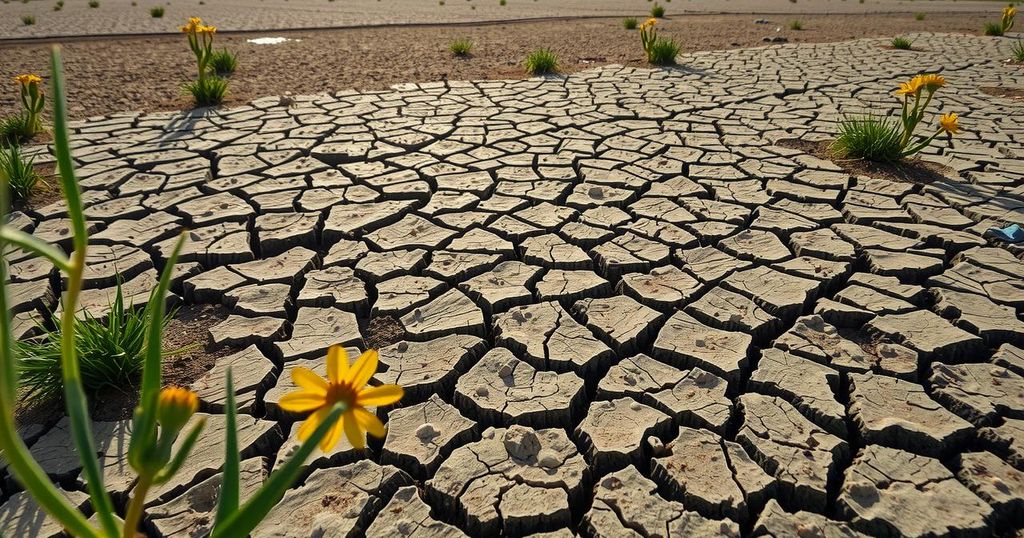A recent report reveals that drought-affected land has tripled since the 1980s, with 48% of the Earth’s land surface experiencing extreme drought in 2022. This rise poses significant risks to water, food security, and public health, illustrating a troubling connection between climate change, drought, and flooding. The report emphasizes the urgent necessity of addressing greenhouse gas emissions to mitigate these impacts.
A recent report has revealed that the area of land impacted by drought has increased threefold since the 1980s. The Lancet Countdown on Health and Climate Change reported that in 2022, nearly half (48%) of the Earth’s land surface experienced at least one month of extreme drought, a significant rise from the 15% average seen during the 1980s. Moreover, in 2023, about 30% of the world underwent extreme drought conditions lasting three months or longer, compared to just 5% in the previous decade. The findings underscore the rapid acceleration of drought occurrences globally. Extreme drought, defined by six months of very low rainfall or high evaporation levels, poses dire threats to water security, food supply, public health, and economic stability. The complexities behind individual drought phenomena are influenced by various factors, including natural climate events and human land usage, with climate change currently shifting global rainfall patterns that exacerbate drought susceptibilities. Regions experiencing the most significant increases in drought include South America, the Middle East, and the Horn of Africa, where drought conditions threaten to alter established weather systems, particularly in the Amazon basin. The research notes a correlation between rising drought incidents and contrary patterns of extreme rainfall, with statistics showing that in the last decade, 61% of the world has observed increased extreme rainfall occurrences. This duality complicates the relationship between droughts, flooding, and climate change, with elevated temperatures contributing to heightened evaporation rates, worsening drought conditions while also leading to increased rainfall intensity. The Lancet Countdown report highlights alarming health impacts associated with climate change, revealing that drought has exposed 151 million additional people to food insecurity relative to the 1990s, resulting in rising malnutrition rates. Heat-related mortality among individuals over 65 has surged by 167% compared to numbers from the 1990s, while the proliferation of mosquito-borne illnesses such as dengue fever has reached unprecedented levels. Furthermore, the emergence of dust storms has increased air pollution, endangering millions worldwide. Specific regions such as northeast Syria and parts of Iraq are suffering from acute drought conditions, with reports indicating that cities like Hasakah now struggle to provide clean water to their populations. Efforts to create new wells often result in contaminated groundwater, leading to health concerns among residents. In South Sudan, nearly three-quarters of the country experienced at least one month of drought last year, drastically affecting food security as flooding further complicates the situation, leading to instances of widespread illness. As temperatures continue to rise, the urgent necessity of mitigating greenhouse gas emissions is apparent. The report warns that if global temperatures continue to increase, both drought and intense rainfall events will only become more frequent and severe. By 2023, it was noted as the hottest year recorded. The executive director of the Lancet Countdown, Marina Romanello, emphasized the precariousness of current climatic adaptability, suggesting that a failure to address emissions could lead to dire and unavoidable consequences.
The article discusses a study conducted by the Lancet Countdown on Health and Climate Change that reveals alarming statistics regarding the increase in drought-affected land since the 1980s. It highlights the critical relationship between climate change, drought, and public health, emphasizing the compounding effects of extreme weather events, including both drought and flooding. The content serves to illustrate how these trends are impacting global food security, water availability, and health outcomes, calling attention to specific geographic areas that are experiencing severe droughts and the resulting humanitarian crises.
In summary, the assessment provided by the Lancet Countdown indicates that drought conditions have escalated dramatically, tripling the land area affected since the 1980s, which poses significant risks to food security, health, and economic stability worldwide. These findings underline the urgent need for global action to reduce greenhouse gas emissions and to seek adaptive solutions in response to a rapidly changing climate. Without substantive change, the increasing prevalence of drought and extreme rainfall may lead to catastrophic impacts for human populations and ecosystems alike.
Original Source: www.bbc.com






